Back in Bay Ridge again, eh? I can’t help it, I lived there for 35 years after my birth at Maimonides Hospital in Borough Park in 1957. Gradually my connections with the place have slipped away. My parents died in 1974 and 2003, various relatives who lived in Bay Ridge or Borough Park have died or scattered to the wind, and even many of my favorite dining spots like Zeke’s Roast Beef, the Tiffany Diner and even the Nathan’s on 7th Avenue and 86th Street have closed. I periodically visit for checkups and cleanings at my dentist’s office. I’ve been going to the same office since 1964 and have been treated by only two dentists the entire time. The latter presided over the removal of my front four and the ensuing bridge and plate. That’s loyalty!
The allure can’t be denied. I cannot swim a stroke and burn like baloney on a frying pan in the sun, but Bay Ridge’s proximity to the water was always a charm for me. (When I was hired at the World’s Biggest Direct Marketer in Port Washington, I couldn’t believe my good luck when the place was a stone’s throw from Manhasset Bay. Two layoffs later, the place has moved to a landlocked office park in Jericho.)
There is one walk in Bay Ridge I had never taken. Bay Ridge Park is sandwiched between the Belt Parkway and Shore Road between 4th Avenue and Bay Ridge Avenue (69th Street, as the locals say). I had entered it only a handful of times in 35 years. I had never ridden my bicycle in there, preferring the bike path on the Narrows side: perhaps admonitions from my overprotective grandmother, who warned me away from where the “bad boys” were, kept me off Shore Road Park’s paths, which can be isolated in spots. So today was the day. Sunny and rather oppressively humid (now just about every day in NYC between July 1 and September 15 is oppressively humid) I sallied forth to a park I had rarely been in, in the place I lived for 35 years.
Bay Ridge Park, as we know it, has existed since the 1940s, as it was landscaped in more or les its present condition after the Circumferential Parkway opened in 1940. (Soon after that, NYC took pity on typesetters everywhere by formally changing it to Shore Parkway; the entire system of parkways rings Brooklyn and Queens and is colloquially called the Belt Parkway.)
However a park of some sort along the Narrows had been in the works since the late 1800s, when a consortium that included Frederick Law Olmsted, the co-designer of Central and Prospect Parks, was a member, drew up landscaping plans. Little of those original plans remains. For example, Fort Hamilton Parkway was once planned to be a green “arm” of Prospect Park, as Ocean and Eastern Parkways are today, and FHP, Leif Ericson Park, and Shore Road Park were once going to be a continuous row of green, supporting horses, carriages, strollers long before the internal combustion engine was conceived. Of course, FHP wound up a pedal-to-the-metal truck route, its diagonal course across the grid ideal for trucking. Even Lief Ericson Park was sundered in two by the Gowanus Expressway beginning in 1959. Henry Stewart of HeyRidge, in his new (2019) book, How Bay Ridge Became Bay Ridge, provides Shore Road Park’s full story. Stewart, with the website and book, has become Bay Ridge’s foremost chronicler.
Taking the R train all the way to the end at 95th Street, I noticed that the station has a pair of anachronisms. The station has an island platform with trains on either side, and its electronic “next train” indicator still gets the job done after what must be several decades. The station has a lengthy, IND-style underground corridor (it was completed in 1925, and may have been a dry run for subway designers, including Squire Vickers, to create such concourses for IND stations that would shortly be built). There are mosaic signs pointing to 93rd and 95th-Street exits, and what appears to be a functioning men’s room; I did not test it, and it may be storage, which are what most former public subway bathrooms are now.

As a kid growing up at 6th Avenue and 83rd Street there were three libraries about equidistant from me: the Fort Hamilton, a branch opening at 4th and 95th via one of industrialist Andrew Carnegie’s library donations; the Bay Ridge, a modern building opened in 1963 at Ridge Boulevard and 73rd; and the Dyker Heights, at 13th and 83rd, a building that reflected the charmless esthetic of 1970s architecture. Most of the time, I wound up here at the Fort Hamilton. It was completed in 1905 and designed by architects Lord and Hewlett.

There are no shortage of World War I Memorials in Bay Ridge, including two within a few blocks of each other. The first is here at the triangle formed by 4th and 5th Avenues and 94th Street. The names of those soldiers who trained at Fort Hamilton and served or passed away during World War I are inscribed on a granite shaft erected in 1917.
For years the triangle was known as Pigeon Park, both for the fowl that flocked in the park and for the homing pigeons used to carry messages during WWI and WWII, but it was formally named Fort Hamilton Triangle by Parks Commissioner Henry Stern in 1998. It is currently surrounded by a locked gate to discourage vagrancy in the park.
When Bay Ridge streets were laid out in the 1800s, 4th and 5th Avenues came to a meeting place here, with only one avenue proceeding south to the Narrows. 4th Avenue was selected to proceed south, presumably because it’s the “senior” number.
The car dealership in the background was once a restaurant that served as the coffee shop in which Tony Manero (John Travolta) and Stephanie (Karen Lynn Gorney) discuss Brooklyn vs. Manhattan life in Saturday Night Fever.
The Roman Catholic St. Patrick’s Church is one of the oldest Catholic parishes in Brooklyn; the church was instituted in 1849 to serve the Fort Hamilton area’s many Irish laborers and their families, and has also served Catholic military men and their families stationed at the fort. The present church building was completed in 1925, the same year the BMT was extended to 95th Street; its school building on 4th Avenue and 97th Street opened in 1958.
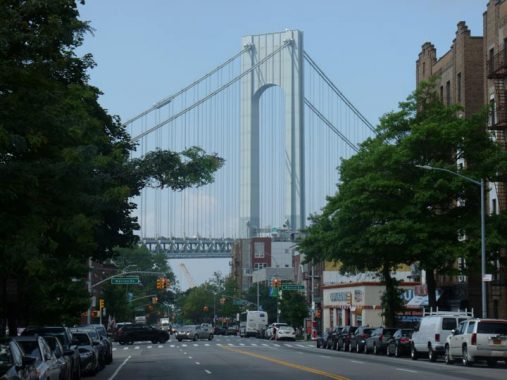
The Verrazzano-Narrows Bridge, seen from 4th Avenue and 97th Street. My own experience watching the bridge’s construction has been referred to in various posts on numerous occasions, so I won’t belabor it again here, but if you haven’t read it, here it is, complete with vintage images from 1964.
When Googling the bridge, it’s best to spell it without the extra z. Historical groups succeeded in getting the extra z formally included in 2018, though the explorer himself spelled his name in various ways — as was the practice until increased literacy and printing technology standardized the spellings of proper names and places.
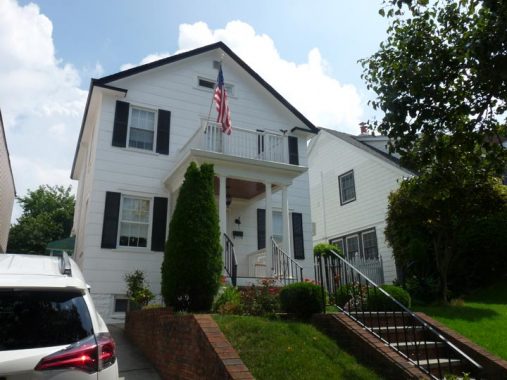
A handsome private home, with a “widow’s walk” above the entrance pediment. When it was built, the platform allowed residents a clear view to the Narrows.
Barwell Terrace is a pleasant cul de sac on 97th Street between 3rd and 4th Avenues, one of a legion of such that were built in Bay Ridge by real estate companies in the early 20th Century. Some allow vehicular access, some don’t. Barwell Terrace, built by the Barwell Homes company in 1926, boasts 18 small single family brick homes, 9 on each side, arranged to face each other across a walkway. Brooklyn Dodger shortstop Pee Wee Reese was a resident in the late 1950s.
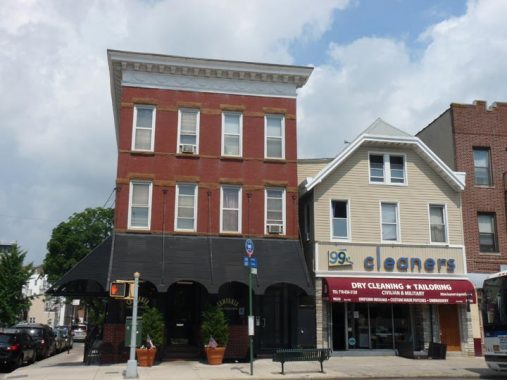
I’ll be forgiven if I inject some personal notes into my Bay Ridge posts. In the 1980s, I was dissatisfied with the heat in my place on 73rd Street and was seeking lodging elsewhere and looked at some places in this area, in the 90s near the waterfront. I liked an apartment in this building, but was turned down by the owner, who was also the proprietor of the restaurant on the ground floor, as well as an apartment in a building on 96th Street. The real estate broker told me that sometimes, people don’t rent to single men in their 30s, fearing noise and ruckus. Who, me?

Across the street, this TD Bank branch at 4th and 99th Street stands in place of the Tiffany Diner, which was here from the 1960s into the late 2000s. As a rule, our shopping day was Saturday. We would get the groceries delivered, so more often than not, we would sally down here for lunch. There were other places we went, such as Surprise Diner on 5th avenue or the Green Tea Room on 86th Street.
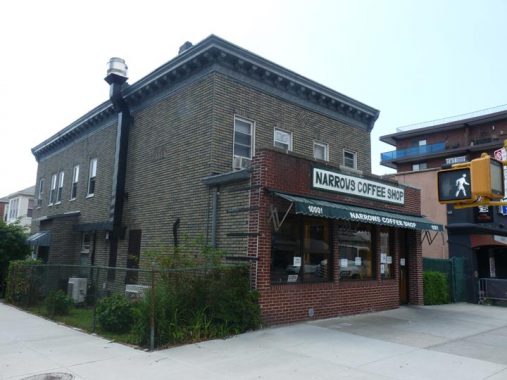
Oddly my parents never thought to patronize the Narrows Coffee Shop a block away on 4th and 100th Street. I had lunch there approximately 5 years ago. The building itself appears to have been here for a century or longer.


Naval hero John Paul Jones (1747-1792; the bassist for Led Zeppelin has the same name, coincidentally) is known as the Father of the American Navy (though sometimes John Barry is given the same title). Jones enlisted in the Continental Navy in 1775 and distinguished himself in service, captaining the sloop Providence and the warships Alfred and Bonhomme Richard. Jones attacked a British convoy that included the HMS Serapis and Countess of Scarborough. His vessel damaged and sinking, Jones continued to press the attack, shouting “Don’t give up the ship!” The Serapis was later captured by the Navy. Jones later served in Russia and France, but died of nephritis at age 45.
This was originally the southern end of Shore Road Park, but was renamed for Jones in 1969, so this is the park’s half-centennial with the name.
The Dover Patrol Monument in John Paul Jones Park actually honors a Naval unit that served during World War I, protecting the British coast from German U-boats; this monument, a gift from Britain and the tallest obelisk in Brooklyn, honors American participation and assistance in the war effort. There are identical such monuments located in Dover, England and Cap Blanc Nez, France. The monuments were designed by Sir Ashton Webb, who also designed the façade of Buckingham Palace. The obelisks employ 14,000 total tons of granite.

John Paul Jones Park is chockablock with history honoring three different wars. This Revolutionary War Memorial consists of a bronze tablet on a granite boulder that New York City received from the Long Island Society of the Daughters of the American Revolution in 1916. The first resistance to British troops by the Continental Army took place in this vicinity during the American Revolutionary Battle of Brooklyn.
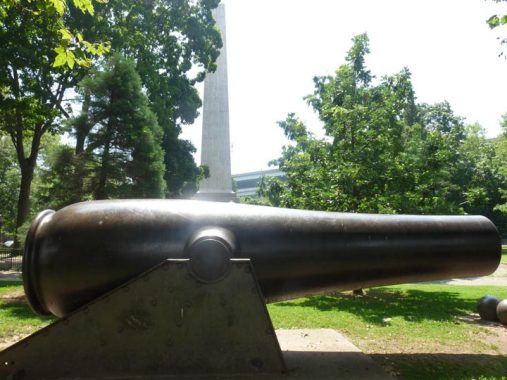
John Paul Jones Park is the site of one of the three 20-inch Rodman guns ever produced. Fort Hamilton, in 1864, tested this new cannon, designed by Capt. Thomas Jefferson Rodman, which weighed 58 tons and fired shot weighing 1080 pounds up to 4 1/2 miles. A derrick had to be used to load the cannon. The cannon’s effectiveness was judged minimal after it failed two trials.
Shortly after being mounted the piece was fired four times with 50-, 75-, 100- and 125-pound charges. In March of 1867 it was again fired with charges of 125, 150, 175 and 200 pounds of powder. At an elevation of 25 degrees a range of 4-1/2 miles, was obtained.
These were the guns that established the International “Three Mile Limit” for Territorial Waters. In the 19th and early 20th century a nation “owned” those waters that it could defend with cannon fire.
One of the two Rodman guns produced wound up here, along with a goodly number of cannonballs in what is commonly known as Cannonball Park. The second was located at Fort Hancock in New Jersey, and is now on display at the Sandy Hook National Park Site; the third was sold to Peru. Records of this cannon were lost during Peru’s war with Chile from 1879-1883.
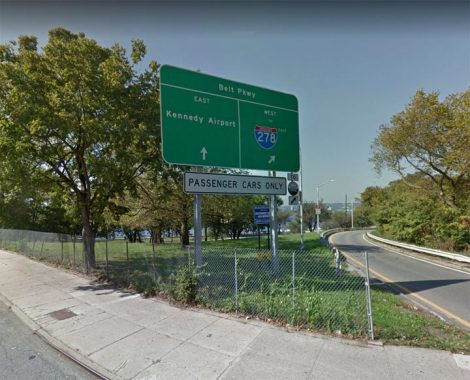
A westbound on-ramp for Shore Parkway is located here at 4th Avenue and Shore Road. I have never seen a sign quite like this one, with minuscule type on a huge green field. Seems to me the type could have been made larger and broken into two lines.
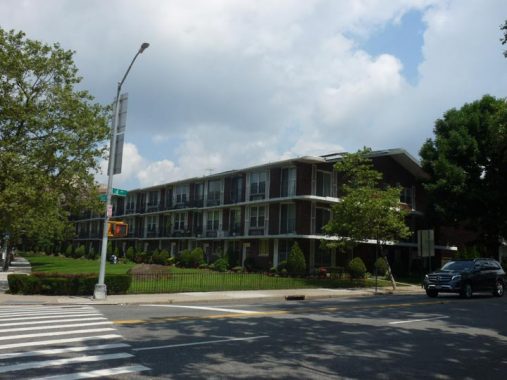
This apartment complex at 4th Avenue and Shore Road was an athletic field throughout my youth in Bay Ridge. The apartments were built in the late 1970s or early 1980s. The end building has the highest 4-digit numbered address in Brooklyn, #9999.
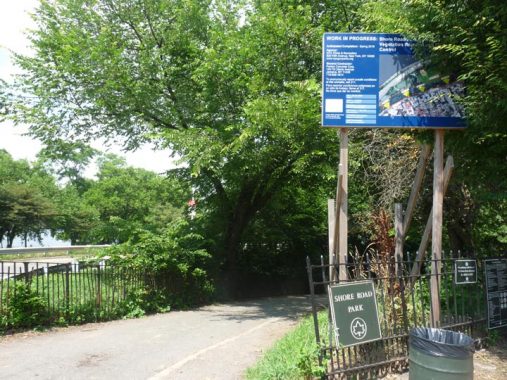
Previously, upon attaining this spot, I would head up Shore Road proper, or cross the 4th Avenue bridge over Shore Parkway to the Narrows waterfront, most often on a bicycle. Most of the time I would ride the “whole magilla”, either north to the 69th Street pier, then reverse and head to Caesars Bay at Bay Parkway where the path ended, or do the opposite.
Today, I’m descending the path into Bay Ridge Park, where I was once told the “bad boys” were.
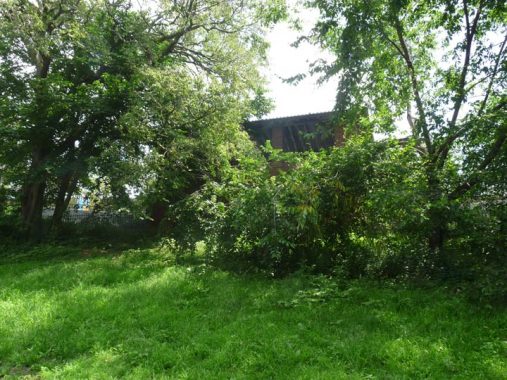
I am looking up toward the brick shelter on Shore Road, the terminal of the B63 bus that takes 5th and Atlantic Avenues to the Brooklyn Bridge Park waterfront. I was always puzzled about the purpose of this shelter, but I imagine it was mainly so people could get out of the rain; but no other park has this feature, except Prospect Park, which has an ornate pair at Park Circle.
I usually didn’t enter this one, as it usually smelled of piss.

Steps ascend to 4th Avenue from this stretch of the park. These are normally proportioned steps, but other hills which are lengthy are tackled by staircases that feature some of the lengthiest, shallowest steps I’ve seen in NYC.
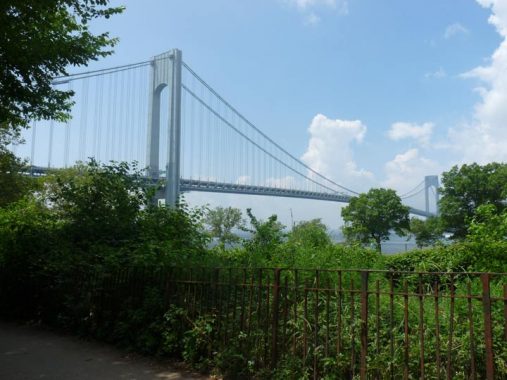
Glimpses of the bridge are easy to come by here.
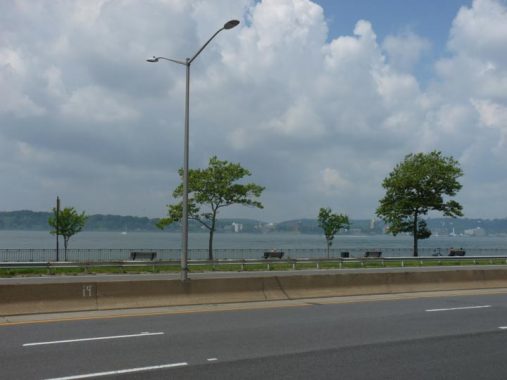
On occasion the park path edges close to Shore Parkway, and views of the Narrows side park path and the Rosebank and Clifton sections of Staten Island across the water.
Donald Deskey lamps, first introduced in 1958 and used extensively beginning in 1962, are peppered liberally along the park paths. Their modular nature is featured here, as they carry floodlights used to illuminate athletic fields. A few have the short masts usually found under elevated trains.
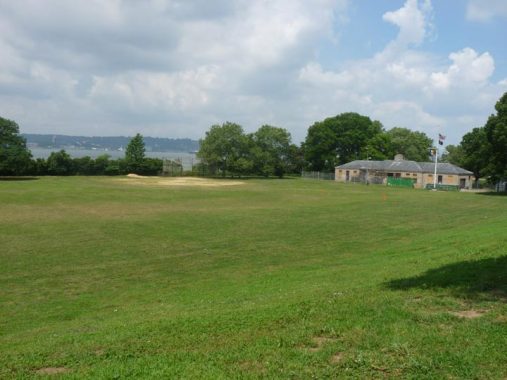
A large, meticulously maintained lawn and field house at approximately 96th Street. More heavily publicized parks such as Brooklyn Bridge Park and the High Line in Chelsea and jampacked with tourists and residents alike on summer weekends, but Shore Road Park was mostly depopulated, except for the occasional jogger or dogwalker. Perhaps my grandmother’s admonition about lurking “bad boys” was taken to heart by other generations of Bay Ridgeites.
I happened upon a brand new staircase and handicapped ramp near the lawn.
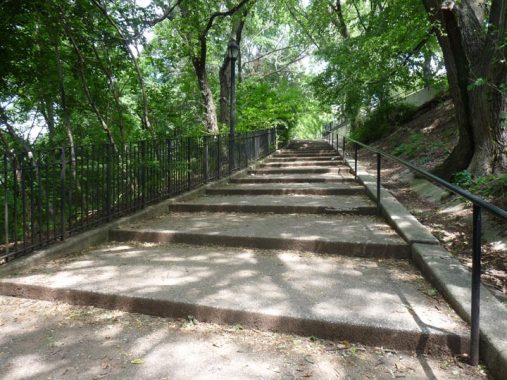
The steps I was referring to. I’ve seen these in Riverside Park as well but they’re relatively rare.
A word about the Shore Road fences and railings. Now, these are stone cold classics. They look like medieval torture devices, something the Man With The Iron Mask would be shoved into. What the city wants to do is prevent people from getting over the fence into the heavily wooded barrier that is on the “ridge” between Shore Road and the park. It’s the “ridge” that Bay Ridge takes its name from, with the Narrows being the “bay.” Look at these things, they’re perfect.
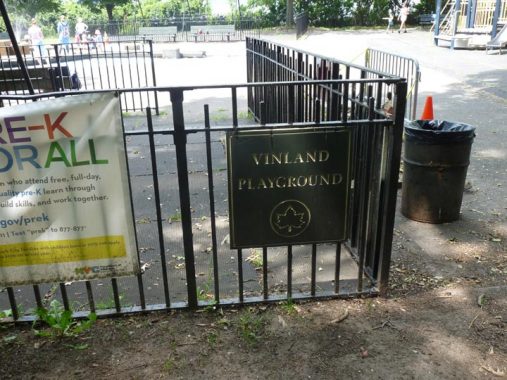
Henry Stern, Rudy Giuliani’s Parks Commissioner, could be playful about how he named things. As is well known, Bay Ridge had a lot of immigration from Scandinavia, Norwegians, Swedes, Danes and Finns, as workers were attracted to the dock work available in the early to mid-20th Century. A thousand odd years ago, the Norwegians were a seafaring group (the Danes were the more warlike Vikings) and some even sailed west across the Atlantic Ocean, settling Iceland and reaching Greenland (ultimately it became a Danish possession) and some made Newfoundland and even further south. Noting that grapes grew in this unplumbed land in the warm months, they named it “Vinland.” The age of Norwegian exploration ended almost as soon as it began, and Europeans did not mount another sustained period of exploration and conquest in North America until nearly five centuries more.
Old records and maps show that there was some kind of seaside roadway following the shoreline of the Narrows as early as the late 1700s. Soon enough, the name “Shore Road” was settled on for it though “The Shore Road” appellation was used on maps into the 20th. Before streets were laid out, Bay Ridge was seen as a seaside resort for the wealthy, who constructed large mansions within view of the water. Beginning in the 1920s these mansions were sold off and razed and in their place, large, multifamily apartment buildings went up.
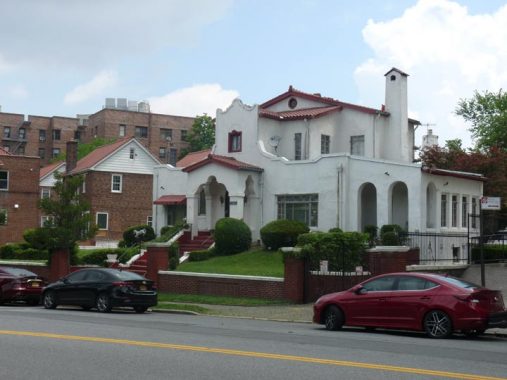
Occasionally you do see a reminder of the old days such as this Spanish Colonial manse at a#9000 Shore Road. Others turn up around 80th-82nd Streets.
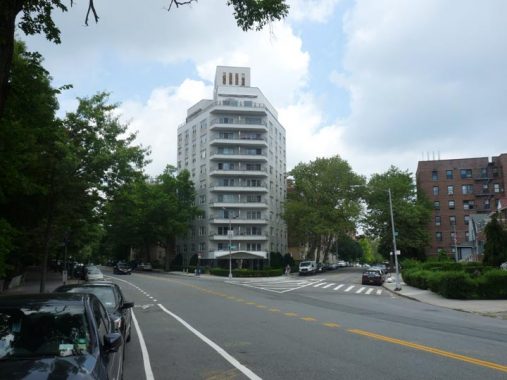
The multibalconied Harbor View Towers, at the V formed by Narrows Avenue and Shore Road.
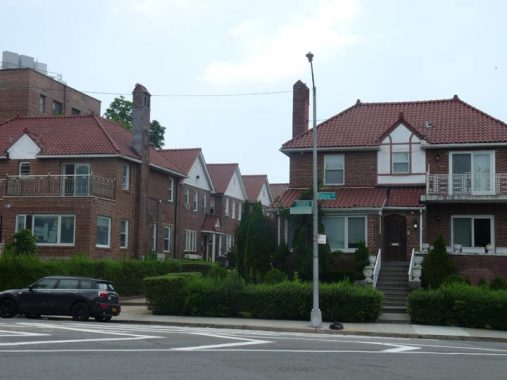
Colonial Gardens, opposite the Harbor View, is another British-style garden terrace lined with tidy brick buildings, much like Barwell Terrace (see above).
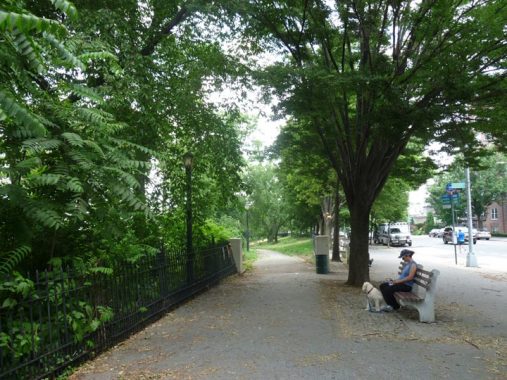
Why am I on Shore Road and not Shore Road Park, where I’ve said I would be? The park is interrupted as the space between Shore Road and Shore Parkway narrows. Soon enough, at about 88th Street, a path edges back down into the park.

I didn’t attend Fort Hamilton High School, which has lorded it over Shore Road at 83rd Street since the 1940s. It resembles the archetypal high school that Wally Cleaver or Richie Cunningham would have attended, and it’s much more visible in the colder months from Shore Road Park. Real-life alumni/ae include Janet Yellin, former chair of the US Federal Reserve; the NBA’s Albert and Bernard King; and rocker C.C. DeVille.
I do have a past with Fort Hamilton High. In the spring, St. Anselm Youth Activities had its annual gala at FHHS, and I was able to meet several well-known (at the time) sports stars, whose names escape me now.
Located at about 80th Street, this is the northernmost iron pedestrian bridge over Shore Parkway to the Narrows-side path. Built along with the parkway in the late 1930s, these bridges represented what was likely the last ornamental concession Robert Moses made in public works, as the bridges are stylish with ornamental scrollwork. Along the Belt Parkway between here and 27th Avenue, there are four similar bridges.
When bicycling north on the Narrows path, this is the spot where the Manhattan skyline and Statue of Liberty appear. I was always fascinated that I could see them from Bay Ridge. Actually the towers pictured here are in Jersey City and did not exist when I lived in Bay Ridge.
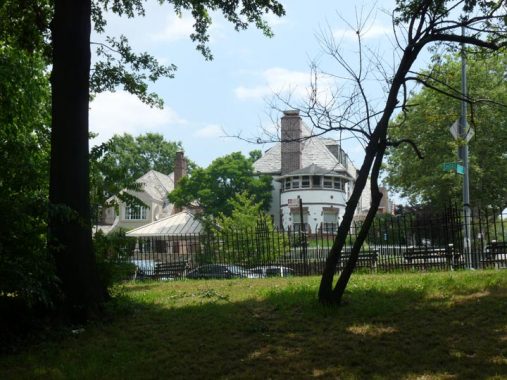
One of those voluminous private homes on Shore Road in the 80s I was talking about. That circle-shaped ell must have a nice view of the water.
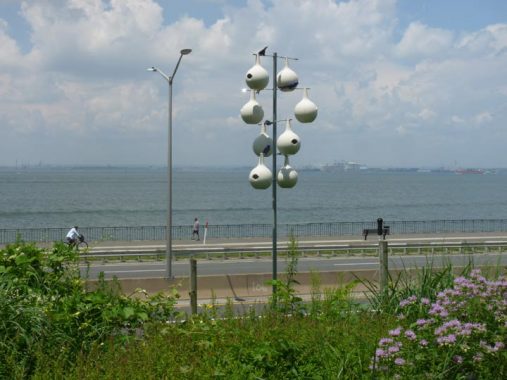
Unusual birdhouses of this type are employed by purple martin keepers. Martins migrate to South America for the winter months, but spend spring and summer here. Native Americans discovered that the martins would nest in empty gourds that they would hang on trees. The martins were useful because they preyed on insect pests, and the hanging gourds made them less susceptible from attacks from hawks, raccoons, cats, etc. The martins got used to the gourds, so the present birdhouses are shaped like them. The birds became so dependent on man that today, no eastern purple martins nest in the wild — only in shelters provided by people.
One of my aims on this walk was to see the Narrows Botanical Gardens, instituted in this stretch of the park opposite Xaverian High School at 71st Street in 1995. I didn’t know much about them, so I’ll quote from NYC Parks:
The transformation of Narrows Botanical Gardens began in 1995, when neighbors organized to clear the land, removing garbage and weeds. To prepare for plantings, wood chips were spread across the ground. Local nurseries donated plants and shrubs, which were watered with hoses supplied by the Fire Department. As members of the community began to recognize the results achieved by the reclamation effort, more people asked to contribute. Official memberships were offered after the group received non-profit status. In 1997, Parks recognized the efforts of these residents when the gardens received their current name…
The gardens in this park are meant to satisfy the senses with colorful flowers, aromatic plants, and singing birds. The Native Plant Garden contains local flora, such as plants and trees, as well as a waterfall, stream, bog, and pond that provide for fish, toads, frogs, and turtles. The fragrance garden contains shrubs, lilies, honeysuckle, sage, mint, and mock orange, creating different aromas throughout the year. The moon garden contains white and silver flowers that reflect the moon’s light. A butterfly garden uses milkweed plants (Asclepias) to attract migrating monarchs. Narrows Botanical Gardens also contains two rose gardens and a Japanese Zen rock garden where residents can go to meditate. In addition to these gardens, the park contains many other natural settings, such as a lily pond, redwood (Sequoia) groves, a linden (Tilia) tree alley, and tree arboretums.
Donations are appreciated: see their website.

69th Street (Bay Ridge Avenue). This is home again to NYC Ferry, which runs a few boats to and from Manhtattan in the mornings and evenings. It’s something, but not quite the same as in the old days: dozens of runs to St. George, Staten Island in heavy, large boats until the Verrazzano Bridge opened in 1964. Was there ever Manhattan ferry service from here?
A pair of well-maintained “jewelbox” houses on 69th Street between Narrows Avenue and Shore Road.
Belgian blocks rule on Bay Ridge Place between 69th Street and Ovington Avenue — but only half the one-block street! Half a loaf is better than nothing.
Storm clouds were mounting, and I was hustling to the Bay Ridge Avenue R train at 4th Avenue. The first drops fell as I went down the steps. #winning
8/4/19

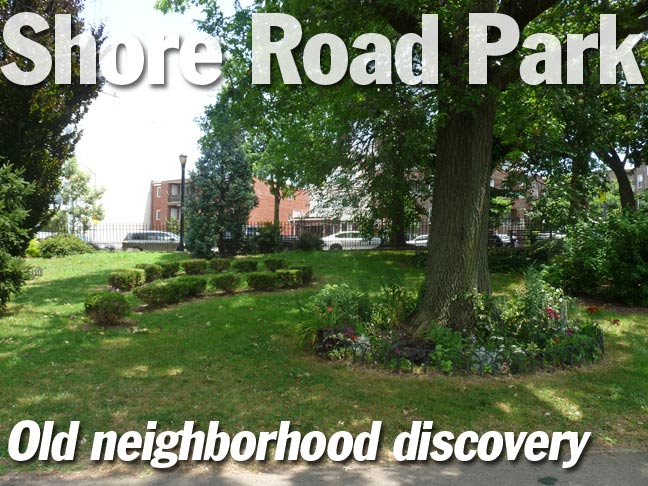
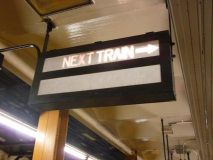
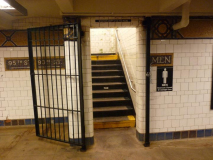

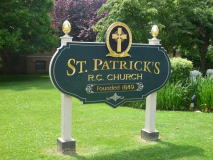
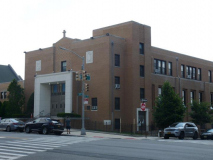
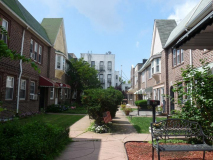
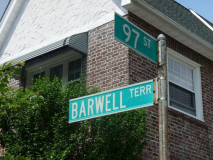
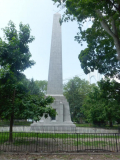
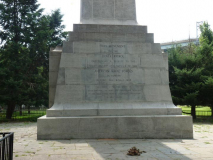

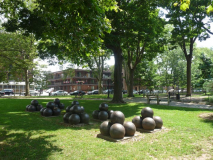
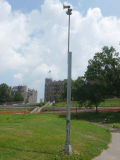

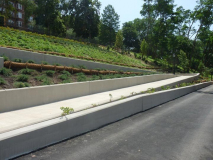
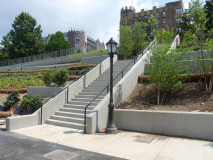

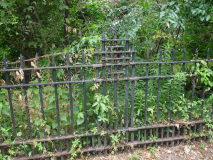
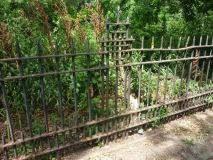
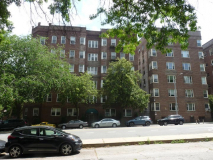
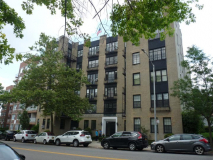
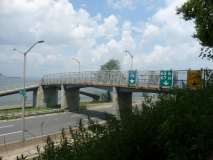
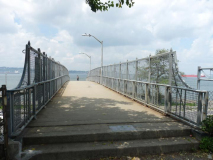


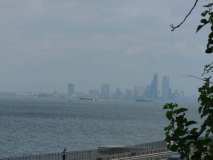

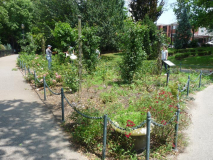
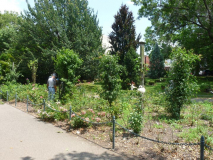
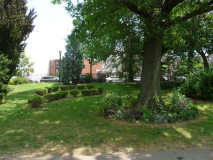
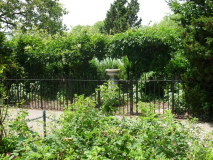
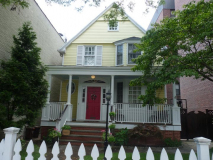

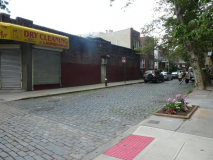
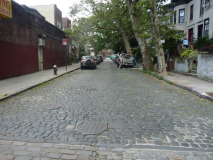
37 comments
It’s actually a stage name. The Led Zeppelin guy’s real name is John Baldwin.
I lived here my first two and a half years in Brooklyn. Almost twenty-four years ago a young lady and I had our first date, a walk through Shore Road Park (after a short motorcycle ride on the side streets). We celebrate our 23rd anniversary next week. It was a long train ride between 95th Street and 96th on the Upper East Side. It was even longer when she came down to Bay Ridge after work; she worked at the Melrose Library near Yankee Stadium. I lived in the apartment complex on 101st Street, literally in the shadow of the bridge. The Narrows Coffee Shop was a great place for a cheap breakfast.
Love the article on Shore Road. The sites brought back great memories. Played baseball, softball, football and roller hockey there. I remember the free concerts there on Friday nights during the summer. Did my summer training for college track there. Thanks.
Thank you very much for this entry. It’s been several years since I was in Bay Ridge, and you showed many of the changes.
I have memories of being in the coffee shop where 4th and 5th Aves. meet. I ate at the Tiffany Diner many times including the evening after my daughter was born at Victory Memorial Hospital.
Good ol’ Shore Road Park. Spent lots of time there as a “yute” at the playgrounds and playing pickup games of football and baseball with a gaggle of cronies at the ball fields (both by 79th and 95th Streets). I remember as a kid back in the early 80s the whole stretch from 69th out to the VZ was in an advanced state of disrepair with LOTS of jungle-like overgrowth, missing benches, busted lighting, grafifti, etc. thanks to the 70s fiscal crisis. Thankfully over the next 25-30 years, the Parks Dept began to spend some serious $$$$ to fix the place up. It looks a lot better in 2019 than it did 30-40 years earlier. Re: ferry service from 69th Street, there was only service from St George to Bay Ridge until 1964. There was some form or another of ferry service to Wall Street only from about the mid ’80s to some time in the 90s when the pier was closed because it was in danger of falling into the harbor.
Beautiful article
Re: ferry service from 69th Street Pier to Manhattan, as far as I know there have been a few brief attempts to operate a commercial ferry over the last three decades, but generally the service has not been well-used. The current ferry run to Brooklyn Army Terminal seems to be better utilized. Historically, I believe 69th Street was not used for service to Manhattan during the time that it was the connection for Staten Island (pre-bridge).
I was born in Maimonides Hospital in Borough Park in 1955. Greetings to a fellow Maimonidean.
Thank you for a most enjoyable tour of the area I spent the first 25 years of my life in. I still return there as often as possible (I live just across the bridge) and still love to walk along the Shore. As a child in the 40’s and 50’s we spent a great deal of time in the playgrounds and picnicking with our parents and friends. It’s still a beautiful place to live or visit.
Correction:
The Bonhomme Richard sank after the battle with HMS Serapis. The Serapis survived the battle and was captured by the Americans.
Hi. Sorry for being nitpicky and possibly overly pedantic, but another correction, which I should’ve caught earlier:
During the Revolutionary War, John Paul Jones’ famous quote in the battle of the USS Bonhomme Richard vs. HMS Serapis was “I have not yet begun to fight!” As detailed in the book “Night On Fire”, the Bonhomme Richard was a somewhat rickety and inferior ship and it was taking a fearsome pounding from the Serapis’ weapons. When asked by the Serapis if they would surrender, this was Jones’ response. The Americans ended up winning the battle and capturing the Serapis, but the Bonhomme Richard was so badly damaged that it sank.
“Don’t give up the ship!” was what James Lawrence said to his crew aboard the USS Chesapeake during a battle vs the HMS Shannon in the war of 1812. Despite his dying command, the Americans did indeed lose the battle and the British captured the Chesapeake.
Two different famous quotes, two different wars, and two different battle outcomes (the Americans winning the first, the British winning the second).
I read “Night On Fire”s condensed version in the Readers Digest several years ago and recommend it for those interested in an interesting, historical read.
This brings back a lot of memories. I grew up on 94th Street, between Shore Road and Marine Avenue, so I played in that park as a young boy.
I believe there was a ferry from Whitehall Street to Bay Ridge/69th St. at one time, but it probably stopped running after World War II. The best source of information about NYC ferry history is the excellent book Over and Back, by Brian Cudahy (Fordham University Press, 1990). The book has a comprehensive list of ferry routes that once plied New York waterways.
Anyone know the flagpole on shore rd maybe hi 80’s. The American, NY State flag? Is there one maybe on north side is it missing? Just to resolve a disagreement
are you familiar with St. Angela Hall Academy on Shore Road ?
And the Visitation convent/monastery on Ridge Blvd and 8????? St.
Very interesting and historic
The oblesik at Jones park was to the USN’s Dover Patrol, not the RN. Further along Shore Road is a plaque to Commodore Dewey, the hero of Manilia Bay in the Spanish-American War. Gravesend Bay was where the British Fleet anchored for the Battle of Long Island. My mother’s family moved to Ft. Hamilton in the early 1900s to a house at 141 Battery Ave and then to 94th and Ft. Hamilton Parkway where my grandfather opend his saloon.
Thanks for the memories! In 2008-09, had a nice second floor apartment at 90th St and 7th Ave that overlooked Dyker Beach Golf Course. The former Staten Island boy in me felt right at home as that block is very suburban, especially for Brooklyn. Came home late from work one night and found a big white goose sitting on my front porch. Had to gingerly sneak past him to get in! Good times, especially the Nathan’s at 86th and 7th. Finally had to leave Bay Ridge and head back to Staten Island because my commute via walking, the R train, and then transferring to IRT Lex Ave line was just too slow to get to my job in Midtown. My commute from Staten Island was faster, and SI rent was $300/month cheaper.
I was born in Maimonides Hospital in 1944, when it was named Israel Zion hospital. . Thanks fo4 a tou4 if m6 ol$ neighbo4hood
Funny that you were born at Maimonides Hospital but grew up in Bay Ridge. My folks were living on the outskirts of Borough Park (Parkville) when I was born at Bay Ridge Hospital on Ovington Ave in 1948. Dr. Flickinger, who delivered me, also served as our family doctor, and did my hernia surgery at Norwegian Hospital (4th Avenue) in the mid-50’s. Many doctors did it all in those days! As a Physician Assistant in the mid-90’s, I did clinical rotations at Coney Island Hospital, Methodist Hospital, and Maimonides Hospital, but the others were long gone. I wrote a long comment about my Verrazzano Bridge memories in the earlier cited post.
Despite your claim to have never seen a sign reading Belt Parkway, one of the photographs in your tour shows an entrance sign to ….. the Belt Pkwy!!!
You’re right. I’ll change it.
I enjoyed this beautiful article, which brought back many memories!
I noticed that you say of Shore Parkway that it “is colloquially called the Belt Parkway, but that title cannot be found on any signs.” Yet the photo of the westbound on-ramp at 100 Street and 4th Avenue has a sign that reads “Belt Pkwy.”
I was born at Shore Road Hospital, which I believe was behind and to the right of the camera position in the view of Harbor View Towers, perhaps someone more knowledgeable can confirm that. Delivered by Dr. Julius Yellen, Janet’s father.
Shore Road Hospital was torn down and replaced by the Harbor View Towers in the mid-70’s. See https://www.brownstoner.com/history/past-and-present-shore-road-hospital-bay-ridge/
I remember two ferries from South Ferry-the obvious one to Staten Island, and another to Brooklyn. This would be 1950’s through early 1960’s.
Xoxoxo hi thank you for the beautiful photos and well written history of bay ridge. I grew up a stones throw away in sunset park between 4th and 5th ave. dancing and dining was always at one place or another in bay ridge back in the day. so much fun excitement and love to go around. This article brought tears of joy to my eyes as I remember my youth,thank you for that.sunset park and bay ridge with all its glory and majestic beauty will forever be in my heart. God bless❤️ love Angelarose
Thank you for the evocative tour through my old neighborhood. I was born in Methodist Hospital in The Slope, educated by the Dominican sisters at St. Patrick’s and the Xaverian brothers at Xaverian. The ugly apartment complex at 99th Street was indeed a ball field, owned by the parish, built and run by the fathers of the parish. Two perfect diamonds set amidst the beauty of the area. Of course, the Diocese of Brooklyn soon enough sold it in their greed, but until then it was maintained as well as a MLB park by our fathers, all of them WWII vets who coached as well as built and maintained the fields. They would arrive at practice or a game with the equipment in their old duffle bags – bats, balls, catcher’s equipment. It was unheard of to own a bat. Unlike modern youth sports, fathers were not permitted to coach their sons’s teams. Hence, my father, brother, and I played on three different teams. Whenever I hear Sinatra sing There Used to be a Ballpark I think of this field as well as Ebbets Field, which was empty by the time I came of age.
Although the public library on 4th Avenue and 95th Street was a block from school and a couple of blocks from home, its location as the terminus of the subway and several bus routes made it a seedy place and I would walk the 20 blocks or so to the “modern” library on Ridge Blvd. rather than have to fend off the advances of the chickenhawks in the 4th Ave. branch.
My first job was at about 7 years old at the local pharmacy. “Doc” as we called him, would let me sit in the corner in the air conditioning quietly reading until needed. And my job? When a prescription had to be delivered, I would take it on my bike and my wages would be whatever tip the person would offer.
My mother would use the large variety of local stores for different items, fish at one place, beef at another, chicken at a third, breads and pastries at a fourth and fifth.
Finally, my sons once asked if I used to go to the “famous” Grimaldi’s for pizza and I told them it was unheard of to leave the neighborhood for a slice. Different pizzerias had their different styles depending upon what you wanted at the time. But to get on the subway to travel for a slice of pizza? Fuhgeddaboudit.
Hi Kevin!,
The bathrooms at the south end of the 95th street station are indeed open. They’re not the cleanest, but they’re good for an emergency.
I live on Shore Road and it’s been very nice reading about some of the history in the area both in this article and in the comments. I’ve often wondered what that apartment complex on Shore Road and the corner of 4th avenue used to be. Now I know it was a ball field! I’ve also wondered what the abandoned gated area inside the very southern section of Shore Road park was. It’s located near the winding staircase that leads up to fourth avenue and the brick canopy. It seems that at one time there was a sand pit in there, so it must have been a playground. These days it’s just a place for people to let there dogs go to the bathroom.
So many memories from Shore Road, from playing in the grass near the old Fort Lafayette while my Dad fished, later the Brooklyn tower of the Verrazano, to attending Fort Hamilton HS. Last apt. I lived in was on 86th & Ft. Hamilton Pkwy. My Dad and older brother worked on the Verrazano Bridge construction, iron workers.
That’s my neighborhood! Explore it thoroughly every year. Thanks!
Hi,
Thank you for this article and the journey through your memories and experience living in Bay Ridge.
I grew up there, but was moved to the West coast in my early teens. I remember playing little league as a child at Shore Road Park, but am having a hard time remembering which field it was. I am thinking it was the Frank Schnurr field, but am curious if that was a baseball field back in 1980-1981? Can anyone recall?
Hi
New Contribitor .. born Victory memorial 1934. my earliest years were at 59 73rd St.. at Narrows Ave.. You questioned whether
Manhattan Ferries ran from 69th St Pier.. No, only to and from St George… Frequent service… lots of traffic on 69th street! A lot of neighborhood kids in the mid to late forties would take the boat to St George, bet on the Staten Island RR. ( appeared to be subway cars) We would get of at Grant City, hike up the slope to the vast Flagg estate.. woodlands and ponds.. Watchmen would try to run us off, bot without much success..
Frank Exline
The other cannon.
https://goo.gl/maps/ptBMQYfA3bzKEQY19
I was born at Norwegian Hospital in 1939 and lived on 73rd street between Ridge Blvd and Colonial Rd until 1959. We lived across from Flagg Court. Usually had summer passes to that pool. Anyone remember the prince and princess who lived in Flagg Court? They were legendary. Often went to Shore Road to bike ride. My siblings went to Ft Hamilton HS, and one sister took the ferry to Staten Island daily tattend Notre Dame College there. There was never a ferry direct to Manhatten = had to go to SI and then pick up the ferry to Manhatten. Everyone in our neighborhood took either the 69th St or 77th St subway to get to the city. We loved the old Bay Ridge library – What a shame it was torn down and replaced by a less than pretty building. Often took the Seabeach express direct to Coney Island. Then my mother decided the water there was polluted. So by then we had a car and upgraded to Reis Park, and thence to Rockaway Point and Breezy Point. Having been to numerous beautiful beaches (among those in Hawaii, Greece, the Caribbean, the Carolinas), I think Breezy Point is among the top = wide, swimmable water, destination walk (the Jetty), no sharks that I’ve heard of. I went to a diocesan girls high school – St Brendan in Flatbush. Used to take what I think was the No. 9 bus all the way to Ave O and E. 16th St from 69th and Ridge Blvd, for a nickel. Across the street from our house on 73rd Street, just below Flagg Court, was an open area down to Colonial Road. We had a victory garden there during WW II, and there were tennis courts/an ice skating rink .Clay courts, no less. Our house was about midway between Ridge and Colonial, and the street about in front of our house was paved with bricks down to Colonial Road. Made a great sledding ride in winter. With other kids playing traffic cop, we could ride all the way from the top of the hill and cross Colonial Road onto the other side of 73rd St.
Thank you for bringing back such WONDERFUL memories of Bay Ridge. I lived on 96th and Marine Ave for 20 years. I’m a Fort Hamilton High School graduate,
Bay Ridge will always be HOME to me